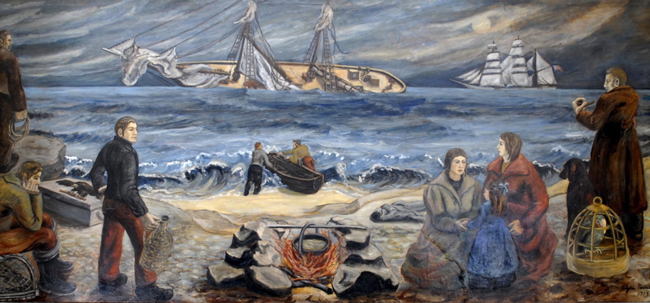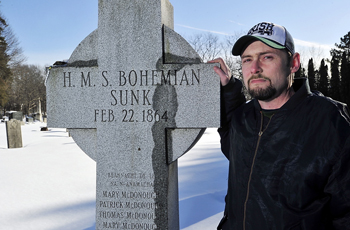The Wreck of the Steamship Bohemian
by Tom Seymour

The 1864 wreck of the British steamship RMS Bohemian seen in this mural inside the post office at 15 Cottage Road in South Portland. “Shipwreck at Night” was painted in 1939 by Alzira Pierce.
The story of the wreck of the steamship, Bohemian, contains all the elements of every New England shipwreck story ever told. This includes heroism coupled with howling winds and raging seas, the human desire of people to reap where they did not sow (as in taking goods that washed ashore after the accident) and even government ineptitude in choosing to replace a working light with a silent buoy, a recipe in the making for the worst kind of disaster.
The Bohemian saga also highlights the plight of Irish immigrants in the 19th-century. Forced by famine and lack of economic opportunity, thousands of Irish fled to America in hopes of finding a better life. Many of these people were aboard the Bohemian and made the voyage as steerage passengers, as was the usual custom. Steerage passengers paid the lowest fees.
Here is an account of the tragic end of the steamship, Bohemian.
An ocean haze obscured the view of the mainland as the Montreal Ocean Steamship Company’s steamship, Bohemian, chugged its way toward Portland Harbor.
The ship’s captain, Richard Borland, knew his way around the waters off Portland, and at this juncture, he must have experienced a certain feeling of satisfaction at the successful conclusion of another trip from Liverpool, England, to Portland, Maine.
The rocks had opened
up
the hull in the engine room
and water immediately
began to rush in.
But then, shortly past 7 p.m., the lookout announced the sighting of two lights on shore. One light flashed and the other was constant. Captain Borland instantly knew that these were the twin, or two lights, of the Cape Elizabeth Light Station. At the outset this seemed perfectly normal, but unbeknownst to captain and crew, fate had already intervened.
And so Bohemian continued on its way through the gloom. With no reason to believe otherwise, Captain Borland was convinced that his ship was perhaps six miles from shore. The ship moved very slowly, as was usual given the conditions. It was then that the captain decided to send flares up to notify a harbor pilot that he needed assistance. The crew touched off signal rockets for the next half hour, but no assistance was forthcoming.
According to a contemporary article in the New York Times, “A pilot on a Boston steamer which passed the Bohemian before she struck, testifies to seeing her signal for a pilot, and that the haze made the (light station) lights look much further off than they really were.”
Captain Borland later testified that he had posted two lookouts on the forecastle and one aloft and that the steamer was going dead slow. Even so, Bohemian struck a known navigational hazard, Alden’s Rock, amidships. Previous to this, the rock was marked with a bell buoy. But four years previous, the bell was replaced with a silent buoy, something that offered no warning to vessels passing in the night.
Unfortunately, the rocks had opened up the hull in the engine room and water immediately began to rush in. Then, with all hands at their stations, Captain Borland ordered full steam to the boilers in an attempt to reach shore before the vessel sunk.
With the ship taking on water at an excessive rate, the captain ordered the ship’s guns fired. The starboard gun fired, but the port gun had already been submerged and was incapable of firing.
To add insult to injury, two men in a pilot boat several miles away reported hearing the single gun salute, but attributed it to some vessel at sea celebrating George Washington’s birthday and firing a gun in honor of the first president.
The Bohemian was in a sinking state when the captain ordered his crew to prepare the ship’s lifeboats. Still, the doomed vessel continued on, with every soul on board praying that they might reach the safety of shore before the inevitable occurred.
After steaming full speed for about 10 minutes, water extinguished the boiler fires, leaving the vessel dead in the water and sinking fast. However, at this point Bohemian was about ½ -mile from the Cape Elizabeth Light Station. Here, Captain Borland ordered anchors dropped and lifeboats launched.
Lives Lost

Historian Matthew Jude Barker stands with the Celtic cross honoring victims of the RMS Bohemian shipwreck – “HMS” was an error, he said – in South Portland’s Calvary Cemetery. Photo Gordon Chibroski/Portland Press Herald.
The Bohemian had departed Liverpool with 219 passengers, 200 of which were Irish immigrants headed for a better life in the new world. These sailed in steerage and the remaining 19 passengers had booked cabins. The Bohemian’s crew consisted of 99 men. In addition to crew and passengers, the vessel carried approximately 1 million dollars worth of silks and dry goods.
Three of the vessel’s lifeboats were rated to carry 100 passengers each, while the remaining three were designed to hold 40 persons. An officer was designated to oversee each lifeboat. But although officers and crew maintained their composure, the passengers panicked and swarmed on deck en masse.
Nonetheless, the first lifeboat was filled and lowered without a hitch. Somehow, this lifeboat carried only 80 passengers. The second lifeboat, though, wasn’t as fortunate. While lowering the packed boat, a pin broke, which, according to a New York Times article of February 27, 1864, “…let one end down, throwing the passengers who had filled it into the water; some of the boats were filled, others were not; the men in the boats not filled refused to pull alongside, thus leaving the captain, boatswain, three of the crew, and 70 or 80 passengers on board.”
Other passengers jumped into the sea in an attempt to reach the departing lifeboats. Some were drowned.
At this point, the only alternative was to get the remaining passengers up above the water. This attempt succeeded in getting 50 women and children into the foretop, the water being over the forecastle head. But the people were safely above the waves on the foretop. And there they stayed for the next three hours, bitterly cold and clinging for dear life. The remaining men climbed up in the rigging.
At the end of their three-hour ordeal, the lifeboats returned and rescued everyone who had managed to climb into the rigging. The women and children were lowered into the boats from the rigging, but in the process several persons were struck by waves and swept into the sea.
Bodies continued washing ashore for another two months. Finally, everyone on the Bohemian was accounted for, bringing the death toll to 42.
Those who survived the ordeal were kindly treated, with local residents reaching out to do everything in their power to comfort the stricken.
The Bohemian’s cargo was destroyed and it, too, washed up to shore in long windrows. Eventually, armed watchmen were organized to protect the cargo, but it was a hopeless task. According to an article in the March 8, 1864 edition of the Portland Advertiser, “Packages of valuable goods came ashore, and many articles were washing about the seaweed, boxes of tea, many of them bursted, gloves, neckties, belts, silks, stockings, and every imaginable article, which were fished up by the multitude present.”
The article went on to say, “…it was impossible to secure all the cargo, since spools of cotton, skeins of silk and thread, torn silks, and other fragments were floating about at the mercy of the waves. The saddest of all were three bodies that washed ashore, a little girl, a woman and a man. The man was in a state perfectly recognizable, but we have not learned his name. The sea broke in furiously, the billows rushing in as if rejoicing over their prey.”
Aftermath
The saddest of all were
three bodies that washed
ashore, a little girl,
a woman and a man.
As was usual in such cases, a coroner’s jury was convened. The seven-man jury determined that the causes for the Bohemian’s grounding were several. These included Captain Borland’s erroneous estimation of the ship’s distance from the shore (as mentioned earlier, this was due to atmospheric conditions), the danger posed by the newly installed silent buoy on Alden’s Rock and the pilot’s error in not noting and responding to the signal rockets fired from the stricken vessel.
No carelessness or “want of skill” on the part of the officers was found. Instead, the jury noted that, “after the vessel struck, her officers and men worked with energy and good judgement, rarely equaled and never surpassed, to avoid the loss of life.”
Two months after the wreck, the bodies of 12 victims that could not be identified were buried in a mass grave in Calvary Cemetery in South Portland. Then in 1984, the Ancient Order of Hibernians and the Irish American Club of Portland honored those buried there by installing a Celtic cross made of granite.
Besides the granite cross at Calvary Cemetery, another equally poignant reminder remains visible to the public at the South Portland post office. The mural, Shipwreck at Night, by Alzira Peirce, depicts the stranded vessel, Bohemian, just offshore, people standing at surf’s edge launching a lifeboat and others looking on at the desperate scene.
As if the wreck of the Bohemian at Alden’s Rock wasn’t enough to inspire government to install a more visible and audible marker, the rocky hazard still wasn’t adequately marked in December of 1886. On 23 December of that year, the Canadian schooner Adelaide ran aground on Alden’s Rock.
Fortunately, while the ship sustained considerable damage, no lives were lost.
Just after the grounding, a local reporter quipped, “A common can buoy is the only sign that marks the ledge. A bell or light buoy should take its place at once.”
Today, Alden’s Rock is marked with a red nun buoy.
Those interested in pursuing this story further should consider the informative and well-written book, Great Shipwrecks of the Maine Coast, by Jeremy D’Entremont, 2006, Commonwealth Editions, Carlisle, Massachusetts.
